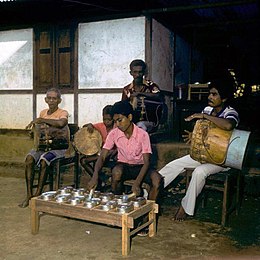Loading AI tools
Indonesian traditional musical instrument From Wikipedia, the free encyclopedia
A tifa totobuang is a music ensemble from the Maluku Islands, related to the kulintang orchestra. It consists of a set of a double row of gong chimes known as the totobuang (similar to set of bonang gong chimes) and a set of tifa drums. It can also include a large gong.[1]
 A Tifa totobuang ensemble, a traditional musical instrument from the East Indonesia region | |
| Classification | |
|---|---|
| Developed | Indonesia (Maluku) |
| Playing range | |
| Pelog and Slendro scales | |
| Related instruments | |
| bonang, kenong, canang, keromong, kromong, kethuk, trompong/terompong, rejong, khong wong yai/khong wong lek, khong toch/ khong thom, khong vong, krewaing/krewong | |
| More articles or information | |
The name comes from the instruments' collaboration. The ensemble can accompany the Maluku Island's Sawat Lenso dance.[2][3]
The custom dates back at least to the late 17th or early 18th century. Gong-chime and drum ensembles, labeled tifa totobuang, were mentioned by François Valentijn, a Dutch army cleric who served in the Dutch army in Ambon, Maluku in two tours, 1686-1994 and 1703–1713.[4] Valentijn talked about hearing "some Javanese lasses sing to the sound of a gong and a tifa (i.e. drum) and of a native zither...a large number of gongs and tifas."[5]
The tifa drums used for the tifa totobuang have been classed into five sizes. These include, from smallest to largest:[6]
Each size of instrument has a different sound, and they are blended together in the orchestra.[6] Different images and videos of the tifas being played show them drummed with empty hands, with sticks and with a combination of the two.
The totobuang is a set of gong chimes. Photos show the instrument in more than one configuration. One is laid out the same as the bonang, in two equal rows.[7] Other images show a square pattern of 9 or 16 gong chimes.
Jaap Kunst, a musicologist who wrote about Javanese music, said that totobuang was probably another word for bonang which could be used for any instrument played with a hammer.[5]
The tifa totobuang played music oriented toward Christians, up until 2000, when there were riots in Ambon.[8] After that, the instrument began to play in cultural events with more "Islamic and Malay nuances."[8] The Sawat dance is associated with traders, Arabs who traded in the "Al-Muluk peninsula". The Lenso is a dance from Christian areas, backed by tambourines, drums, or tifa totobuang.[2] The two were deliberately combined into the modern Sawat by a group of women who wanted to dance together.[2] The result is a modern product that combines two of the country's separate arts, one music and one dance.[8]
Seamless Wikipedia browsing. On steroids.
Every time you click a link to Wikipedia, Wiktionary or Wikiquote in your browser's search results, it will show the modern Wikiwand interface.
Wikiwand extension is a five stars, simple, with minimum permission required to keep your browsing private, safe and transparent.